You set up shop along a productive-looking stretch of the canal and launch a crankbait off into the distance. After a few turns of the handle, you feel a familiar tug on the end of your line.
You set the hook and watch in excitement as your rod doubles over.
You’ve just hooked into your first South Florida peacock bass. This hard-fighting species is as fun to catch as it is beautiful, and fishing for peacocks is the perfect way to spend a day in the sun.
Today, we’re going to take a deep dive into everything you need to know about how to catch peacock bass.
This fishing guide will cover the basics of the fish, how and where to find them, and what to use to target this gorgeous species on your next fishing trip.
Understanding the Peacock Bass
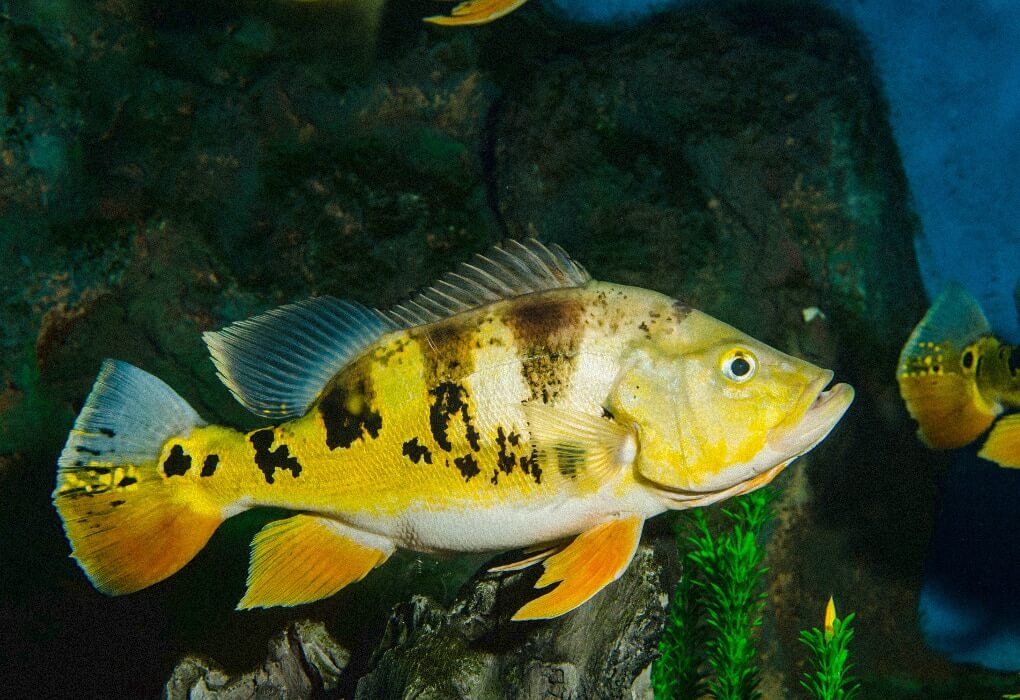
The peacock bass is a member of the cichlid family, a large predatory freshwater fish native to South America.
These fish share a name and some physical similarities with black bass species, such as largemouth and smallmouth bass; peacock bass share no relation to other bass species.
Peacocks are precious fish to a variety of ecosystems. In South America, they’re a valuable food source and a gamefish.
In North America, they’re one of the hardest-fighting freshwater gamefish, and they’ve become a prime target for anglers worldwide looking to tangle with hard-fighting freshwater fish.
Peacock bass are found throughout the Amazon and Orinoco river basins and Guyana, Brazil, Panama, and Venezuela rivers.
The species thrives in warm waters and cannot adapt to water temperatures below 65 degrees, which is why their distribution is concentrated close to the equator.
In 1984, the Florida Fish and Wildlife Conservation Commission purchased peacock bass from Brazil and Peru and spawned the fish in a South Florida research facility.
Once the fish were healthy, ready to breed, and free from parasites, they were introduced to the south Florida canal system.
Peacock bass were brought to Florida to control other non-native invasive species, such as the oscar cichlid and spotted tilapia.
These species were outcompeting Florida’s native species for resources, breeding at a higher rate, and even preying upon native fish.
Not only did the introduction of the peacock bass help address Florida’s oscar problem, but it also provided new angling opportunities for an aggressive, powerful, and hard-fighting game fish.
All told, there are fifteen different species of peacock bass, and the majority of them are only seen in their native territories of South America.
Florida introduced two species, the butterfly peacock bass and the speckled peacock bass.
Butterfly peacocks are medium-sized peacock bass, which can grow to 29” long and weigh up to 15 pounds. Most peacocks are in the 12-14” range and weigh up to six pounds.
These fish typically have a yellowish-green body with black splotches and bright orange fins on each side of their body. The fish’s underbelly is light or bone colored.
Speckled peacock bass is the largest of the bunch, reaching up to 40” long and 25 pounds or more. Their look is quite similar to the butterfly peacock, albeit larger and more muscular.
While the butterfly peacock has black splotches on the body, the speckled variety has vertical black bars which extend to each side of the fish.
Butterfly and speckled peacock bass were introduced to Florida at the same time. While the butterfly peacock stocks thrived, the speckled peacock didn’t acclimate as well, and the species died off in Florida.
Where To Find Peacock Bass

Peacock bass are tropical freshwater fish that are native to South America. These fish are abundant in Peru and Brazil, but you’ll find them throughout much of the continent.
As far as where to catch peacock bass in Florida, the southernmost points of the state are the only place you’ll find these fish outside their natural habitat.
The Florida Fish and Wildlife Commission introduced the fish to the area in the 80s after researching the viability of releasing this fish to combat other non-native predators.
The climate proved hospitable enough to allow peacock bass to thrive. South Florida seems to be the furthest point north where the peacock can thrive, as attempts to stock the fish further north have failed.
You’ll find peacock bass throughout the canal and lake systems of southern Florida, and the further south you are, the better position you’ll be in to catch these fish.
These fish are strictly freshwater and can’t survive in brackish or saltwater environments. Peacocks are also quite sensitive to temperature, and they’ll stop feeding and die off if the water falls below 65 degrees.
Shady areas along culverts, bridges, or dense foliage are the best areas to target peacock bass. Peacock bass also congregate around the ends of a canal or in bends or intersections.
Fallen trees and other forms of structure are also popular staging areas for this hard-fighting fish.
If you’re having trouble finding spots that are holding peacock bass, investing in a portable fish finder can dramatically help your chances of identifying top-producing areas.
When To Target Peacock Bass
One of the best characteristics about this fish is that they’re voracious feeders year-round, so there’s no wrong time to target this south Florida game fish.
The best peacock fishing seems to take place from the late winter into the spring. From February to May, you’ll have a better shot at landing large peacock bass weighing four pounds or more.
Outside of those months, there’s plenty of peacock bass to be caught; they just tend to be smaller than the fish you’ll see through the winter and spring.
While many other freshwater species will eat throughout the day, peacock bass feed exclusively during the daylight hours.
Plan your peacock bass outings between dawn and dusk; you should have no trouble catching these beautiful fish.
Catching Peacock Bass: Best Lures
Peacock bass are aggressive and quick to snap up various artificial lures, from poppers to jigs to crankbaits.
The most substantial part of learning how to catch peacock bass is knowing the best lures for the job, and when to throw them.
Crankbaits
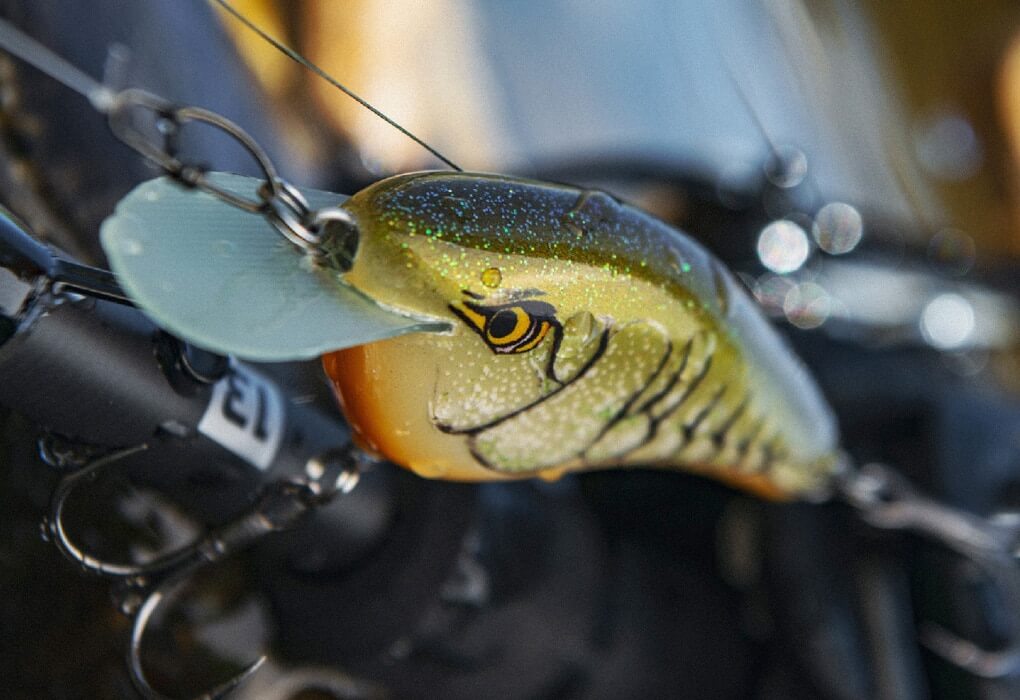
Crankbaits and jerkbaits are exceptionally popular lures that are incredibly productive for large and smallmouth bass. These lures are equally as effective for targeting peacock bass.
Crankbaits can be made from wood, plastic, or composite materials, and they’re shaped and painted to imitate various food sources, such as baitfish or craws.
There’s seemingly no end to the colors, shapes, sizes, and types of crankbait on the market.
Most crankbaits have a bill that extends from the front of the bait, which allows the lure to dive to a specific depth. You’ll find shallow, mid, and deep diving crankbaits, which can be effective depending on your target.
For peacocks, shallow and mid-diving crankbaits, like the Rapala Shad Rap, are usually the ticket.
The most effective crankbaits for peacock bass are typically those in the 2-5” range, as these lures mimic the size of baitfish that peacocks are comfortable with.
Resist the urge to size up your bait to target the bigger fish, as large peacocks are perfectly happy to take smaller lures. Meanwhile, if you use large crankbaits, the small and medium-sized fish won’t be able to bite them.
Considering the tropical climate of southern Florida, bright colors prove especially effective.
Most anglers agree that color patterns like fire tiger, chartreuse, and gold are top producers, and natural-colored crankbaits can prove effective.
Most anglers prefer to throw these lures with spinning tackle, although the best baitcasters can also be used effectively.
Epoxy Minnows
Another wildly popular lure for targeting peacock bass when fly fishing is the epoxy minnow.
These lures look identical to local baitfish, and their size-to-weight ratio makes them an excellent choice for targeting peacock bass, who often feed near the water’s surface.
While most minnow lures are made from plastic or metal and are substantially heavier, epoxy is about ⅓ the weight of materials like lead or brass.
This allows anglers to fish the epoxy minnow in various environments, whereas most metal jigs are better suited for bottom fishing since their weight takes them right to the bottom.
Flashy colors are typically an excellent choice, along with natural shades.
Epoxy jigs can be made with various flashy elements, such as mylar, and the added interest these materials provide is typically more than enough to work peacock bass into a ravenous frenzy.
You can fish an epoxy minnow in various ways. Anglers can allow the jig to sink several feet before beginning their retrieve or use a rapid retrieve to keep the lure closer to the surface.
Both methods can be effective. When targeting peacock bass, reach for lures in the 2-3” range.
Poppers
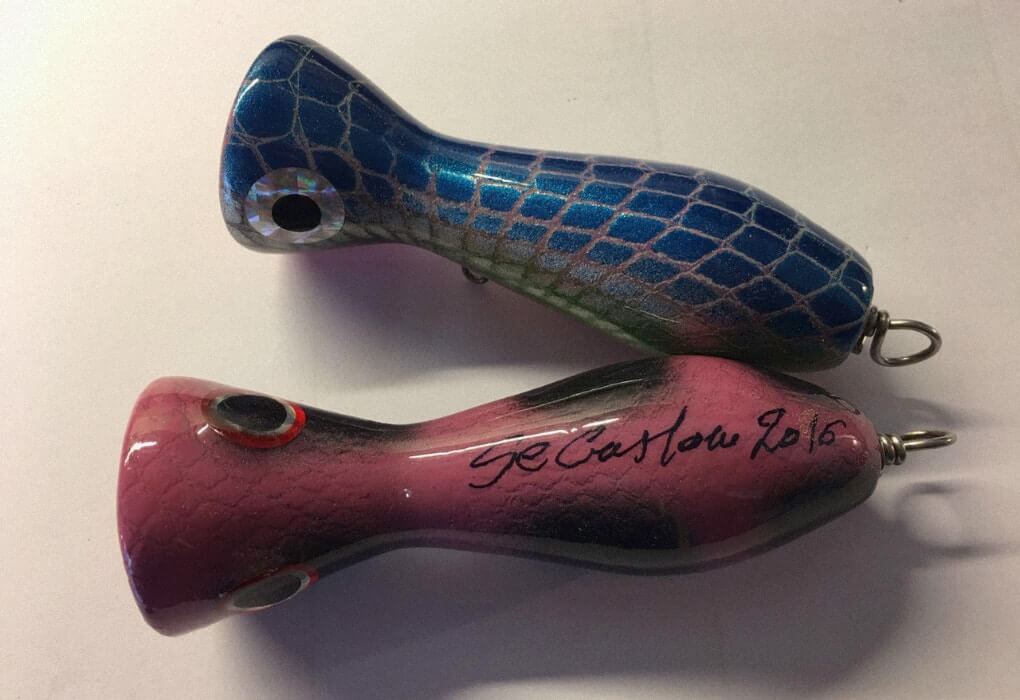
Many anglers, myself included, argue that catching bass on a popper is the most fun you can have.
There’s nothing like watching an aggressive fish blow up on topwater lures at the surface, and it’s a scene that will undoubtedly get your blood pumping.
Topwater plugs and poppers can be made from wood, plastic, or foam, and they have a concave face that cups the water and pushes it away from the lure, which creates tons of action on the surface.
The right popper can mimic anything from a wounded baitfish to frogs, birds, and other creatures.
Since poppers mimic wounded baitfish, they tend to generate the most ferocious strikes of any lure you can use to target peacock bass, especially if the fish are spawning.
The best way to fish a popper is to cast out to an area you think is holding fish and allow the popper to sit in place for several seconds.
Sometimes, the mere sound and water disturbance a popper makes when it lands are enough to work aggressive fish into a frenzy.
After the bait sits for a few seconds, begin a slow retrieve while moving your rod tip horizontally across the plane.
This motion will “drag” the lure forward, which creates more sound and water disturbance, drawing the interest of fish.
Poppers come in a variety of sizes and shapes.
Some of the most popular versions include pencil poppers, which have a thin, streamlined body, and talking poppers, which are usually fatter across the middle and have a larger form.
Fly fishing anglers also use poppers, and they typically have a shorter body with a mylar or silicone skirt to add additional interest.
Beyond poppers, other topwater baits, such as the whopper plopper, can be wildly effective for peacock bass fishing.
Jig and Soft Plastics
The tried-and-true jig rigged with a soft plastic lure is one of the market’s most versatile and commonly used freshwater lures.
While they may not draw the aggressive surface strikes of a popper or topwater lure, they still catch plenty of fish.
These lures have two components: a jig head and a plastic body. There are tons of different styles of baits available, including plastic worms, tubes, and those that mimic other creatures like crawfish or frogs.
The most effective option for targeting peacock bass is a plastic minnow, which looks nearly identical to their common forage.
One of the best parts about these lures is since they have two components, it’s easy to switch out either the head or the body according to what the fish seem to want on that day.
You can easily change sizes and weights to fish at different depths in the water column, which is a considerable benefit when surveying the area and deciding which lures will produce the best results.
When selecting components for this lure, ⅛-¼-ounce jig heads are usually your best bet, although you can choose a heavier jig head if you think fish are holding deeper in the water column.
For the body, reach for shad and minnow shapes around 2”.
Paddle tail plastics will produce the most water disturbance, which is often what’s going to trigger a bite from predatory fish. Split-tail minnows are also quite effective and tend to be the most popular choice for peacock bass.
Brightly colored jig heads such as chartreuse or orange do pretty well with peacock bass, as do brightly colored plastics.
Experiment with different color combinations until you reach a reliable combo-producing fish.
Bucktail Jigs
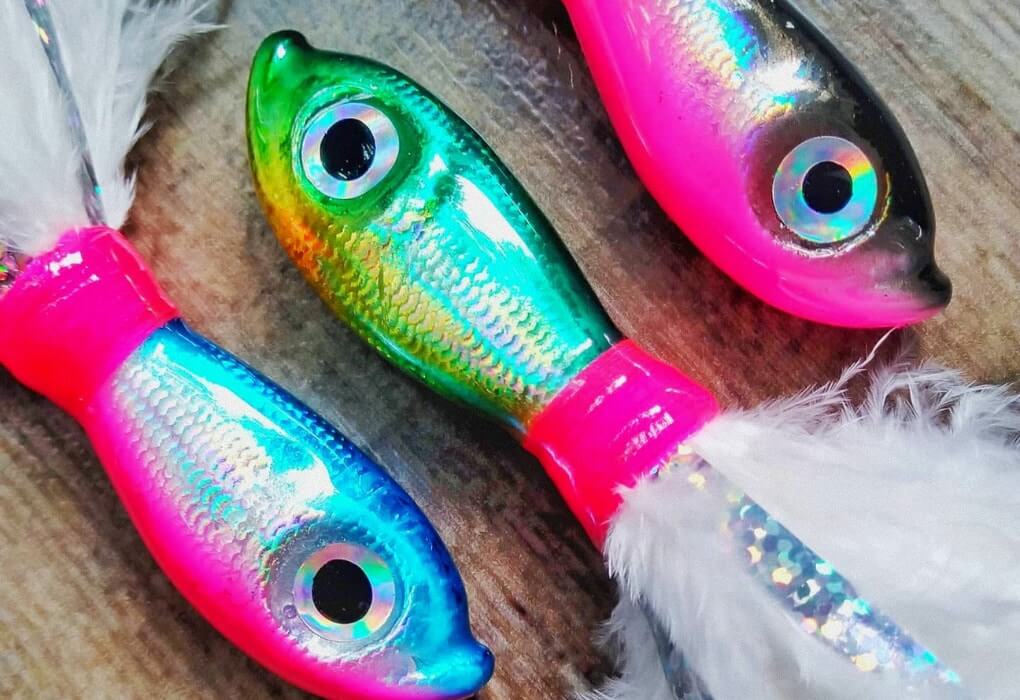
The humble bucktail jig is arguably the most productive fishing lure in the world.
A bucktail is always a top producer, whether you’re hitting the local pond to target panfish, casting for striped bass, or bottom fishing in the open ocean.
These lures can also be deadly effective for peacock bass, although most bucktail jigs require some modifications.
The issue with most bucktails you’ll find at your local tackle shop is that most bucktail jigs that are peacock bass size are typically smaller than 3″.
Meanwhile, peacock bass seem especially interested in bucktail lures when they’re longer, in the 4-6” range. Except for the VMC Moon Tail jigs, most store-bought bucktails are on the short side to target big peacock bass.
To circumvent this problem, take a piece of 100-150-pound test monofilament line and tie it to the eye of your hook.
Trim the line, so it extends about ½” beyond the end of the lure, and then tie on the second clump of bucktail or a bucktail rivet to the end of the line.
Doing so will extend the lure and make it much more enticing to peacock bass.
When fishing a bucktail, opt for ones in the ⅛-¼-ounce range unless you think fish are holding deeper in the water column.
While conventional wisdom suggests you fish your bucktail slow and steady, peacock bass seem more interested in a fast retrieve with some erratic jerking, which mimics the appearance of a wounded fish.
Catching Peacock Bass With Live Bait
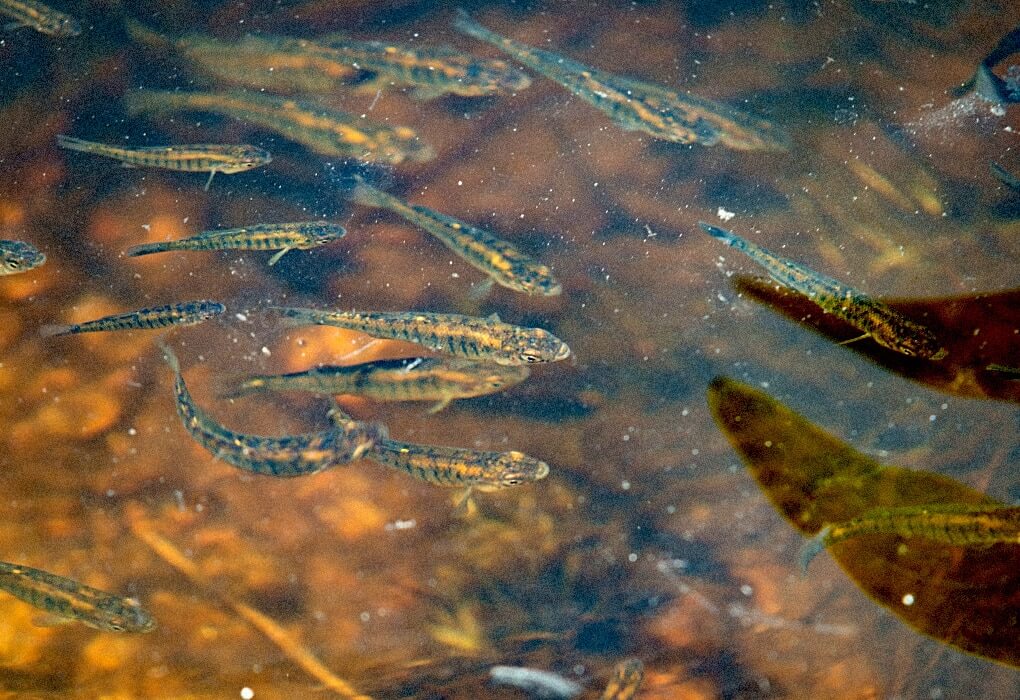
While fishing with artificials can be exceptionally effective, there’s no substitute for live bait.
Live bait is the most effective method for targeting these exotic fish, especially on days when they seem to be turning their noses at every lure you toss out to them.
Using live bait is the best option if you’re a beginner learning how to catch peacock bass.
So, what do peacock bass eat? Peacock bass will snap up a variety of live baits, including bluegill, pilchard, live shiners, and small cichlids.
The golden shiner is the most popular peacock bass bait, so much so that they call it the “peacock shiner” in southern Florida.
Like with most artificial baits, the sweet spot when fishing live bait is around 3-4 inches, as these baitfish will be small enough for the average peacock bass to bite but still very enticing to any monsters that may be holding in that area.
Since peacock bass aren’t incredibly picky when it comes to live bait, this allows the angler to fish in various ways depending on how you hook the bait and how it typically behaves when hooked.
Bluegill and small panfish tend to dive toward the bottom of the water column, while peacock shiners will hold towards the middle and upper part of the water column.
As with all species, your ability to “match the hatch” will produce the best results, using an umbrella net, cast net, or minnow trap to gather bait living in the same waters as the peacock bass will improve your chances of landing fish, and it’s common to net up several different species as you gather bait.
Depending on the size of bait you’re using, a 1/0-2/0 octopus circle hook is usually the best option for rigging. You can rig the bait in different ways, changing how it behaves as it swims away from you.
If you’re looking for the fish to swim deeper in the water column, hooking the fish through the back, just below the anal fin, will allow the fish to reliably swim downward and away from you.
If you need the fish to hold higher in the water column, hook the fish in front of its dorsal fin behind the head.
You can also influence where the fish holds in the water column with split shots, although you’ll risk tiring your bait out faster, affecting its appearance to predators.
Peacock bass are hearty fish that you can catch and release safely in most situations. But, it’s more common for a fish to become gut hooked when fishing with live bait, dramatically increasing fish mortality rates.
For this reason, consider using octopus circle hooks, allowing easier release.
Frequently Asked Questions
As you learn how to catch peacock bass, you may have a few questions we haven’t answered already.
We’ve rounded up the answers to common questions below so you can find all the necessary information in one convenient place.
Are there peacock bass in Florida?
Yes, there are peacock bass in Florida.
The Florida Fish and Wildlife Commission successfully introduced to Florida in the 80s, and today their habitat in Florida runs over 300 miles and is one of the largest peacock bass fisheries.
Can peacock bass live in saltwater?
No, peacock bass cannot live in saltwater. They are a freshwater species. While they’re relatively hearty fish, they must live in a freshwater environment with warm water temperatures.
Where is the best peacock bass fishing?
The best peacock bass fishing is throughout south Florida and South America.
Peacock bass are native to South America, and places like Brazil and Peru offer the best peacock bass fishing in the world.
You’ll find the best peacock bass fishing from Miami north to Broward and Palm Beach County.
Do peacock bass have teeth?
Yes, peacock bass have teeth similar to black bass species, such as the largemouth bass. The teeth are sharp, but they’re nearly microscopic.
When handling a peacock bass by its mouth, the teeth feel similar to a coarse scrub brush or piece of rough sandpaper.
How can you tell if a peacock bass is male or female?
Male peacock bass are larger than females and have a large hump on their head, which develops as they reach sexual maturity.
It’s more difficult to tell the sex of juvenile fish, as the characteristic hump doesn’t develop until the fish is around one year old.
Is there peacock bass in Lake Okeechobee?
There are no peacock bass in Lake Okeechobee. This lake in south-central Florida is home to some of the largest trophy bass in the state.
Unfortunately, you won’t find any peacock bass here. During the winter, temperatures are too cool for peacock bass, which can only thrive in warm environments.
Last Cast
Now that you know how to catch peacock bass, it’s time to gather your rod and tackle box and start targeting these beautiful fish along the canals of south Florida.
Peacock bass are pound-for-pound, some of the strongest freshwater fish, and they put up a fight, so be sure to buckle up and get ready for a fantastic battle.
Is the Peacock bass on your bucket list? Let us know in the comments!




